Music Intervals - How to Recognize and Use Them?
Home » Piano Theory » Music Intervals
Uses of the Intervals - Introducing the Different Intervals - Inversions of music intervals - Augmented and Diminished Intervals - A Handy Inerval Table - Tips on How to Identify Intervals
Inversions of Music Intervals
The meaning of the word inversion is that you could take each and every interval and turn it upside down so that the lower note will be raised and become the upper note of the interval. Bottom line, the relationship between the notes is reversed.
It is handy to be aware of that since it will help you later when you'd like to inverse chords (in order to keep your hand in the same position on the piano).
Another benefit of inversion of musical intervals is that you would be able to distinguish between intervals that sound alike.
When you inverse a perfect 5th you get a perfect 4th for example. Both sound alike to some students.
The minor 2nd and M 7th sound both harsh since they share the same notes only the minor 2nd is having very little distance between the note unlike the major 7th.
Here's a list of qualities and changes of sizes that occur when you inverse the different music intervals.
| Qualities | Size | Example |
|
Major becomes Minor
Perfect remains Perfect Augmented becomes Diminished Diminished becomes Augmented |
3 becomes 6 4 becomes 5 5 becomes 4 6 becomes 3 7 becomes 2 |
 |
Dissonant and Consonant Intervals
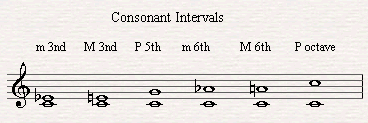
The nature of music exists in movement. Music starts from a certain point, moves through different notes/chord which create tension and release until it finally reaches the final resting point.
In western music the music intervals share a relationship of tension and release. The reason some musical intervals sound more sweet or harmonic then others is because we got used to think of them as dissonant or consonant in relationship with other musical intervals.
The consonant intervals are intervals which are considered to be a resting point the dissonant intervals would lead to them. Here are the consonant intervals...
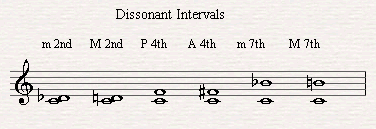
The Dissonant intervals are intervals which contain much tension. They resolve to the consonant intervals.
Here are a few examples of how dissonant intervals would solve to consonant intervals.

About Augmented and Diminished Intervals
Well, until this moment we discussed the augmented fourth and diminished fifth music intervals.
We took a perfect fourth and raised it in half a tone to create a raised fourth or a perfect fifth and lowered it in half a tone to create a diminished fifth.
But what's the difference between these two? Is it only the way their named?
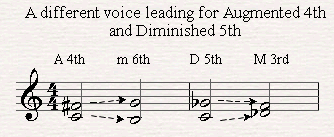
Nope, the difference between these musical intervals has to do with how their going to be solved.
A raised 4th will continue to go higher to the fifth while a diminished 5th would lead down to the 4th note. In the next picture you can see how these dissonant intervals solve to consonant intervals in the expected direction.
If you look further in the picture you'll see that every music interval could be raised or diminished.

When a major interval is raised by a half step, it becomes augmented.
When a major interval is lowered by a half step, it becomes minor.
When a major interval is lowered by two half steps, it becomes diminished.

When a minor interval is raised by a half step, it becomes major.
When a minor interval is raised by two half steps, it becomes augmented.
When a minor interval is lowered by a half step, it becomes diminished.

When a perfect interval is raised by a half step, it becomes augmented.
When a perfect interval is lowered by a half step, it becomes diminished.
A Handy Music Intervlas Table
Finally, here's a useful timetable which summerizes everything what we've learned during this music intervals lessons.
| Interval's Name | Interval on the staff | Number of tones | Impression of the sound of this harmonic interval | Songs that begin with this interval | Dissonant/ Consonant |
| Unison | 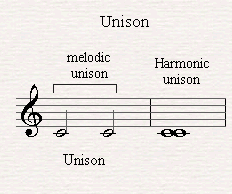 |
0 | No harmonic impression | Twinkle, Twinkle little star | Consonant |
| minor 2nd | 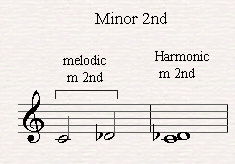 |
1/2 | Harsh | Stormy Weather (Elvis Presley) | Dissonant |
| Major 2nd | 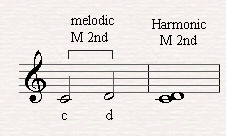 |
1 | Dense but wamer then the minor 2nd | Are you sleeping? | Consonant |
| Minor 3rd | 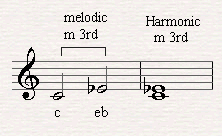 |
1 1/2 | Mellow, Melancholic | So long, Farewell (Sound of music) and The impossible Dream | Consonant |
| Major 3rd | 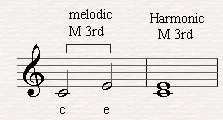 | 2 | Optimistic, Happy | When the saints go marching by or Halls of Montezuma | Consonant |
| Perfect 4th | 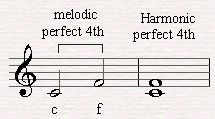 |
2 1/2 | Pure, Like Church Bells | Here comes the bride | Dissonant |
| Raised 4th/ Diminished 5th Triton |
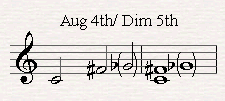 |
3 | The devils interval Sounds creepy | Maria (West side story) | Dissonant |
| Perfect 5th | 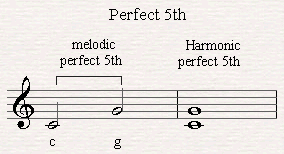 |
3 1/2 | Sound pure as well (an inversion of a perfect 4th) | Star Wars musical theme | Consonant |
| Minor 6th | 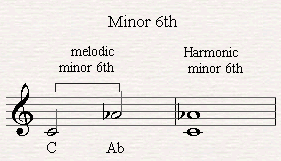 | 4 | Mellow but more distanced then the minor 3rd | Black Orpheus | Consonant |
| Major 6th | 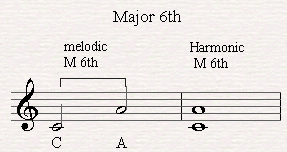 | 4 1/2 | Optimistic but more distnaced than a major 3thd | I did it my way (Frank Sinatra) | Consonant |
| Minor 7th | 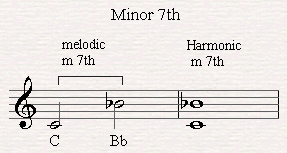 |
5 | A chord full of tansions wanting to resolve to a M/m 3rd | The winner take it all (Abba) | Dissonant |
| Major 7th | 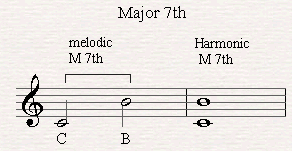 | 5 1/2 | Harsh but more distanced then the Minor 2nd (An inversion of a minor 2nd) | Bali Hai (South pacific) | Dissonant |
| Perfect Octave | 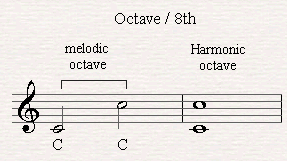 |
6 | One note played in two registers | Over the Rainbow (The wizard of Oz) | Consonant |
How to Identify Melodic and Harmonic Music Intervals?
First of all I suggest you'll learn the names of all the music intervals by heart and be familiar with the songs which are related to these music intervals.
Next, just choose random two keys on the piano and play them one after the other. Try to sing both of the notes (first the lower one). You'll realize that it's easier to sing the higher note then the lower note but don't give up!
Once you succeeded singing both of the notes you could try matching the melody with the related song of the interval you're singing.
As for the harmonic intervals, just play two notes together or ask someone else to do that for you. Ask yourself three questions in this order that will help you get the interval correct.
Are the notes close to each other or far away?
Maybe they're in the middle of an octave? The tritone is right in the middle of the octave so above it will be stated as far and below will be pretty close.
Does the interval sounds dissonant, consonant or pure?
If the interval sounds pure you're hearing a perfect fifth or a fourth. Now try to sing both of the notes you're hearing, and then match them with a song that contains this melodic interval to be sure which one it is. If you hear consonant sound move to number three. If you hear a dissonant move to number 4.
Next you should try to listen if the sound of the interval sounds optimistic, melancholic.
If you feel it sounds happy and the notes are close to each other you're hearing a major third. If it sounds optimistic but far away you're hearing a major sixth.
If the interval sounds mellow and the notes are close to each other you're hearing a minor third. If they're distanced it could be a minor sixth.
Think you hear a dissonant? That's not hard to tell. It will sound harsh in your ears.
If the notes are close to each other you should wonder how close they are.
The minor second sounds really harsh, the major second sound close but warmer.
The Tritone is right in the middle but it is so dissonant that I don't suppose you'll get it wrong.
If the notes are far away you have to doubt between the minor seventh and the major seventh. The minor sounds clearly like the Abba and is more please to the ear then the major seventh interval which is really intense.

It's great that you took the time to learn all about music intervals. Now you can do a few things with the knowledge you just acquired. You can learn to play piano by chords or expend you knowledge in music theory and improve you ability to play piano by ear.
It's a problem to find a comprehensive and an effective piano course that will help you acquire all these skills. This is where Rocket Piano enters the picture. The Ultimate Piano Learning Kit will show you how to play piano by chords and learn to play piano by ear like no other piano course or private teacher will. Click here to check out the Rocket Piano Learning Kit Now!














